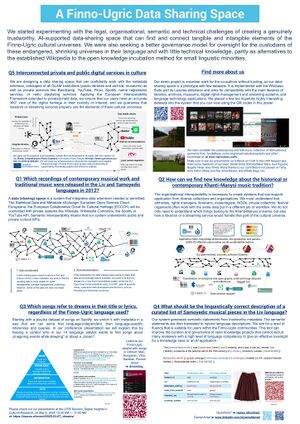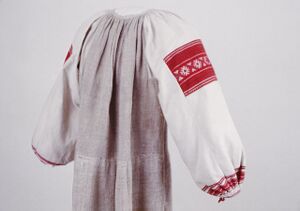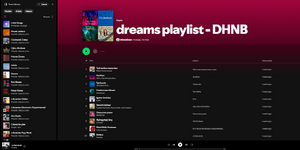Main Page
Finno-Ugric Data Sharing Space

We are building a trustworthy, AI-supported data-sharing space to connect tangible and intangible elements of the Finno-Ugric cultural universes—textiles, music, oral history, photography, and language. This platform explores legal, organizational, semantic, and technical challenges while offering new governance models for community-based digital curation.
Rather than replicating established Wikipedia methods, we work with structured data tools like Wikibase, Lexemes, and SPARQL. Our approach centers multilinguality, shared custodianship, and the ability of communities—Võro, Seto, Livonian, Mari, and others—to describe their own heritage on their terms.
🌍 What is This Platform?
This experimental knowledge graph helps small and endangered language communities:
- Document and connect culturally significant materials (songs, clothing, places, people).
- Create multilingual, multimodal metadata in structured formats.
- Model heritage semantically without needing full encyclopedic coverage.
- Try new digital curation workflows in a low-risk, unaffiliated environment.
The platform is not owned by any national institution and is open for scholars, curators, and communities to test metadata enrichment, federated linking, and feedback models that large systems rarely permit.
For more context, see our project page or slide presentation.
🎵 Collections by Type
Musical Works
Explore works sung in Finno-Ugric languages or belonging to their musical traditions: Livonian • Mari • Finnish • Hungarian • Komi • Udmurt • Estonian • Erzya Moksha • Khanty Mansi • Samoyedic • Veps • Saami
Sound Recordings (Spotify Playlists)
Curated playlists of Finno-Ugric music—traditional and contemporary: Livonian • Mari • Finnish • Hungarian • Komi • Udmurt • Estonian • Erzya Moksha • Khanty Mansi • Samoyedic • Veps • Saami
We are inviting new curators knowledgeable about the traditional or contemporary music of these communities.
📸 Photographs

Contemporary photographs under Creative Commons licenses, each tagged with ISCC codes for digital traceability.
Historical photography focused on Livonian speakers in Northern Courland and the Livonian Coast.
Curated by Daniel Antal and Dr. Ieva Pigozne. Includes multilingual metadata and community annotations. May be used as a primary photographic collection, or as secondary source for other areas, including 🧵garments (see below.)
Where possible, we present both original and enhanced versions of images. Post-processing supports textile research and educational use without compromising historical integrity.
🧵 Garments

Traditional garments worn by Livonians from from the Northern Kurzeme region (Latvia), showcasing weaving, color, and cut diversity.
Historical and ceremonial garments from Setomaa with detailed annotations. Includes primary sources (see kitasnik pinafore dress (STM SSM 782 E) and secondary sources (see the original ethnographic photograph Seto men in the village of Võmmorski in Setomaa municipality (ERM Fk 213:146) and the derivative work: Trousers of a Seto man in the village of Võmmorski in Setomaa municipality (detail))
🎬 Films
Finno-Ugric Film Database (Soome-Ugri Filmiandmebaas):
We are enhancing this foundational database with semantic metadata. Examples include:
Feature films
- Celestial Wives of the Meadow Mari: A Russian drama directed by Aleksei Fedorchenko, filmed in the Mari language and inspired by traditional folklore (2012).
Documentaries
Browse the documentary collection →
- The Land of Love: A Nenets-language documentary by Liivo Niglas (2014).
- Tõnis Day in Setumaal: An Estonian language television documentary by Maie Maasikas (1993).
Short films
Browse the short film collection →
- The Afflicted Animal: A Northern Sámi short film by Egil Pedersen (2016).
- To Speak is to Resist: A Komi-language short film by Taawetti Erkinpoika Myrskyvalkea (2024).
Newsreels & Archives
Browse the audiovisual archive collection →
🗣️ Language & Lexemes

Can machines understand dreams across languages?
By connecting senses of lexemes with their grammatical and semantic behavior, we model language-independent queries. See the Dream Playlist DHNB2025!
🧪 Try It, Change It
This is a sandbox for metadata innovation.
- Test metadata enrichment on real items.
- Experiment with multilingual reconnection.
- Prototype governance workflows.
We invite GLAM institutions, researchers, and community curators to explore new models for cultural preservation.
> Real innovation comes not from new software—but from new participation.